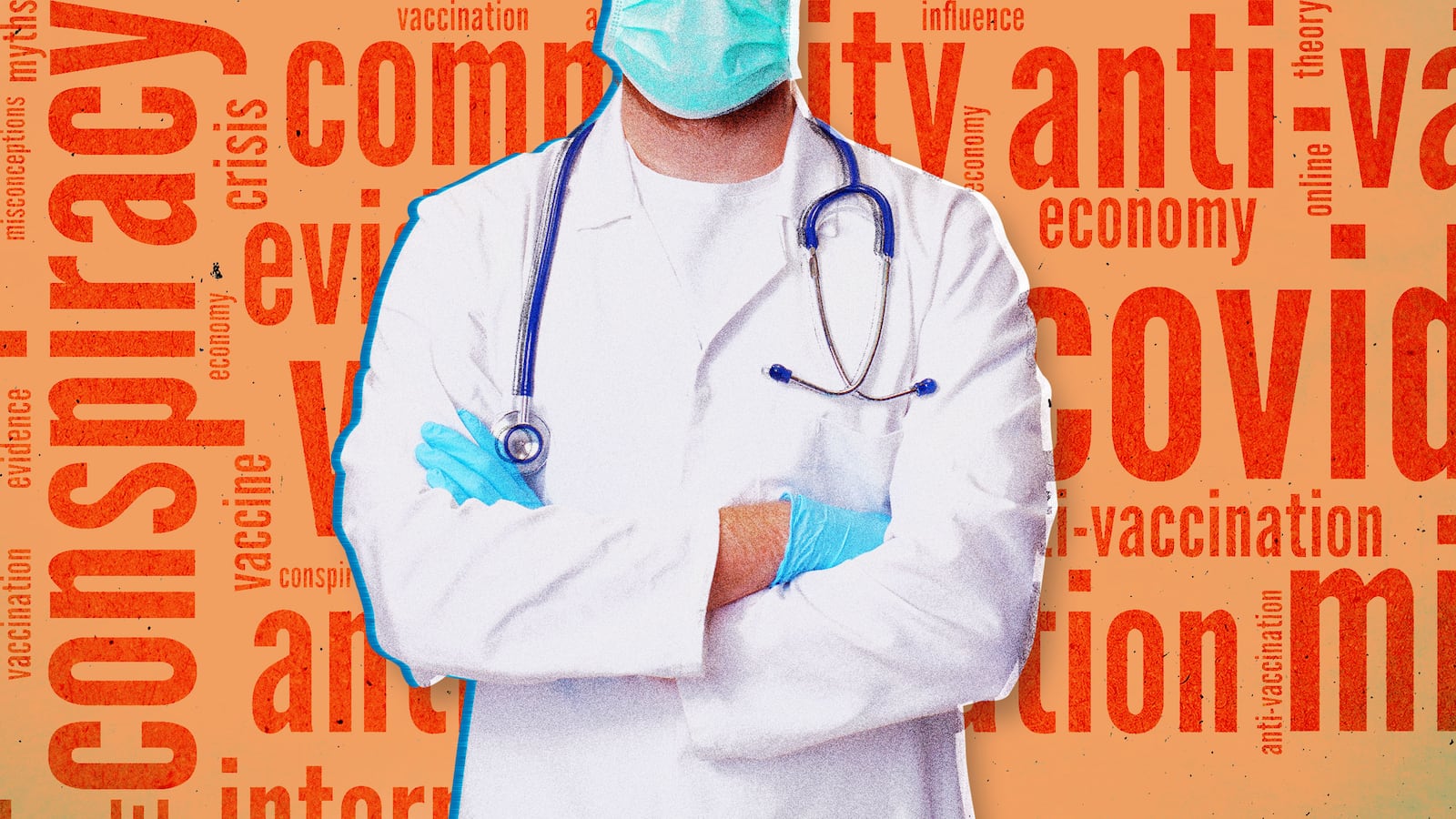After challenging shifts in a packed Colorado emergency room, Dr. Will McNitt goes on Twitter to combat the misinformation that is perpetuating a pandemic in which lies translate into deaths.
Tweet by tweet, McNitt counters untruths with scientific fact, often adding links to peer-reviewed research papers.
“I’ll say, ‘No, that’s true and here’s why and here’s the paper,’” McNitt told The Daily Beast this week. “Usually, I’ll post a link.”
When people cast doubt on the efficacy of the vaccine, McNitt refers them to a pair of studies featured in Nature.
The 36-year-old University of Oklahoma graduate figures he has sent over 1,000 responses to posts in need of factual correction.
“Some days I’ll find five or ten posts, some days it’s one or two,” he told The Daily Beast. “I probably spend an hour a day, but if I get into with someone who keeps running the misinfo train, it can be on and off a few hours of digging into papers.”
He cannot say how many, if any, of the skeptics he has won over.
“I don’t know how much good it does, but there was just this unopposed wave of absolute horrendous misinformation at the beginning of this thing,” he said. “And the problem is folks in medicine—we don’t do PR.”
He believes the effort has value in itself in a state that has recorded 9,860 COVID deaths.
“It’s just there needs to be balance,” he said. “The information imbalance needs to be fixed. So when folks search ‘COVID vaccine side effects’ or whatever on Twitter they don’t find just a list of Nicki Minaj’s cousin stories.”
The falsehoods came right behind the pandemic in March 2020, when COVID-19 had started battering New York and was only beginning to reach Colorado.
“You know a typical response to that would be a huge public health response, contact tracing and testing,” he said. “It started down that road and it suddenly stopped.”
President Donald Trump sought to minimize the danger, saying there were only a few cases and it would soon pass. McNitt and the other doctors at his hospital in the Denver metropolitan area had not yet gotten the results back on COVID tests, but they had patients with alarming CAT scans and lab results.
“That looks like nothing I’ve ever seen before,” McNitt recalled.
As the truth became more apparent and translated into dying patients, the misinformation intensified.
“The sheer volume of it went way up at the end of that summer,” McNitt said. “We watched the first wave of misinformation hit, trying to push people away from shutdowns and the mask mandates.”
McNitt had been using Twitter to express political opinions. But he was now seeing assertions about the virus that he knew as a doctor to be untrue. He began responding to these dangerous falsehoods with tweets of substantiated scientific fact. He would sometimes send dozens in a day, hundreds of “corrections” in total.
McNitt was filling out charts at the end of a long shift dealing with the COVID reality in November 2020 when a patient suddenly turned gray and collapsed. McNitt understood he had no time to don protective gear.
“I realized that if we didn’t get this person’s oxygen up right away, the heart stops and then game over,” McNitt recalled.
He placed a hand-operated Bag-Valve-Mask resuscitation device over the man’s mouth and began pumping air.
“Every time you’re bagging, you’re pulling virus up out of the person’s lungs and spraying yourself with it,” he said. “I took a risk… and I got COVID.”
He fortunately suffered only mild symptoms. The man survived.
“He walked out of the hospital two days later,” McNitt recalled. “It was miraculous. I couldn’t believe it.”

Dr. Will McNitt and his wife, Dr. Cassidy McNitt.
William McNitt/HandoutToo many other patients had already died when hope finally came in the form of the vaccine. McNitt reserved judgment until after he had studied the FDA emergency use authorizations for both the Pfizer and Moderna formulations.
“I said, ‘You know, I’m going to go get this thing,’” he recalled. “I don’t have any problem with it. This vaccine looks good. It was tested on more people than I’ve ever seen.”
Some of the nurses and techs in his hospital remained skeptical.
“I remember talking to folks in the E.R. saying, ‘Oh I don’t know, what is this mRNA thing anyway?’” McNitt said. “People who, you know, they’re exposed to this all day long, sitting there saying they had no idea what to think.”
McNitt understood that it was not enough for the government simply to make the information available.
“People have specific concerns,” McNitt said.
He sought to address them one concern at a time.
“Even if they don’t accept it, there’s a little kernel sitting in the back of their head and the day they’re diagnosed with COVID, they may reach for that kernel and say, ‘You know, maybe this thing is safe and I’m going to get the shot now,’” he reasoned.
McNitt had continued challenging misinformation on Twitter concerning masks and social distancing and lockdowns. The untruths escalated when it came to the vaccine, and McNitt sought to combat them as best he could.
“That was really the point at which I started saying, ‘OK, I’m going on a rampage about this,’” he recalled.
It was the kind of rampage mounted by a physician who meets lunacy and delusion with quiet scientific truth. He noted that what was purported to be a photo of a horrific side effect of the Johnson & Johnson vaccine was actually a 20-year-old textbook photo of a blood disorder called thrombotic thrombocytopenic purpura.
“But of course it’s all over the internet,” McNitt said.
At 64 percent, Colorado had one of the higher vaccination rates in the nation, but there were still plenty of people who refused the jab coming into the ER with COVID. Colorado had the highest new case rate in the nation in October, followed by a dip. McNitt thinks a new surge is likely.
“By far the most common thing they say when you ask, ‘Are you vaccinated?’ is, ‘No, but I assure you I’m going to go get it now,’” McNitt reported. “But there’s some who don’t. They want to tell you about all the usual conspiracies.“
The COVID patients are joined by people who have put off seeking treatment for non-COVID conditions affected by the pandemic.
“We’re seeing our strokes and heart attacks and trauma and all that coming through, and a lot of it’s related to deferred care, where people didn’t get their dialysis or they didn’t get their heart worked up, [and] now they have a huge heart attack,” McNitt said. “They haven’t seen their doctor in months and they’ve got late-stage cancer that nobody diagnosed. You know it’s just been a disaster.”
Some of those with new ailments are also endangered.
“You know we’re a pretty small shop, and if we’ve got 30 people in our waiting room, people are going to wait five, six hours to get seen sometimes,” he said of his ER, which he prefers not to name lest anyone think he is speaking for his hospital rather than himself.
A person complaining of mild abdominal pain can prove to be having a heart attack during the five hours he has been waiting to be seen. And if that patient needs to be in the ICU, it may be full of COVID-19 patients.
“The other issue is our ICUs are full of COVID patients,” McNitt said.
“We get all these people with strokes and heart attacks and all kinds of stuff,” McNitt said. “And they sit for a couple of days waiting for a bed. Just crazy.”
McNitt took a rare day off from the ER this week to hunt for snow geese. He dug what is known as a goose pit in a frigid cornfield, set out decoys, and waited. He, of course, went on Twitter and began an extended exchange with a man who had posted a question that was really an insinuation about masks.
“I try not to leave those unanswered because if somebody else happens upon the thread, I want them to know that the data exist and what the data are,” McNitt said.
McNitt then found himself tweeting in response to a man who doubted the continued need for face coverings.
“How am I having this same discussion with people over and over?” McNitt asked later. “It’s one of those where you just go back and forth forever on it.”
The man would say something and McNitt would cite the actual data and the man would come back with something else and McNitt would cite the data on that.
“Eventually, it just comes down to what they don’t really want to do,” McNitt said. “So, yeah, that’s fine. But that’s a choice that affects a lot of other people.”
McNitt allowed that lately, he sometimes gets “a little snarky.”
“I kind of go around with it, but you know eventually I’m going to say this is selfish behavior,” McNitt said. “That’s what it is. They’re choosing their comfort over other people’s lives.”


